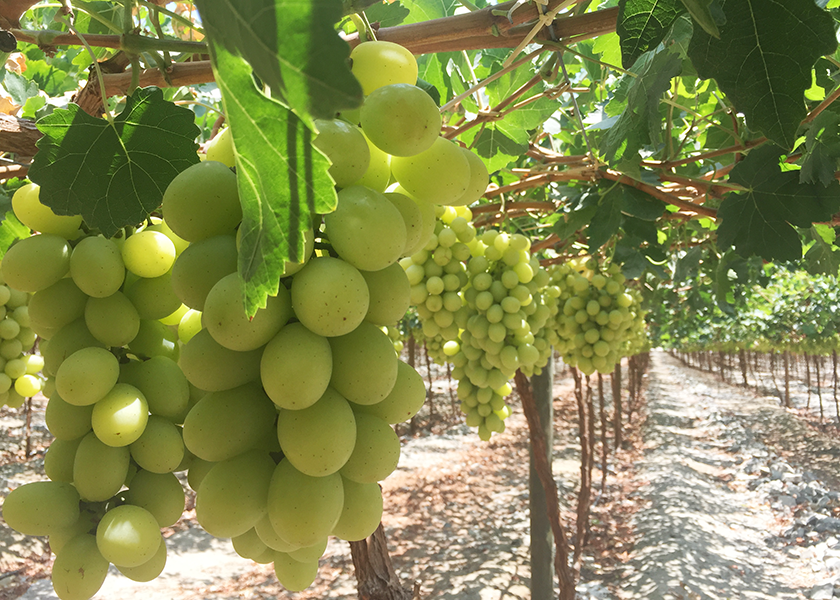Rains hurt Chilean white grapes, spiking spot prices

U.S. imported spot grape prices were rising in early February after heavy rains in central Chile destroyed a good part of the mid-season grape crop.
According to Chile’s fruit growers group Fedefruta, three out of four of the country’s fruit growers suffered some type of damage from the rains, which totaled as much as three to four inches in some regions.
Fruit that was hit by the rains won’t reach U.S. shores until later in February and March. However, the expectation that supplies will tighten, combined with an East Coast snowstorm, temporarily slowed normal distribution and buoyed spot market f.o.b. prices for green/white seedless grapes in early February.
The U.S. Department of Agriculture reported that Feb. 3 f.o.b. prices for extra-large Chilean white seedless grapes arriving into Philadelphia were $28-29 per 19-pound carton, up from $24 per carton on Jan. 29.
Importers said a split grape market, at least for green/white seedless, is likely in late February and early March, with rained-on fruit trading lower than premium fruit.
Growers still need to assess the damage over the next few days, said Ira Greenstein, owner of Direct Source Marketing, Mount Kisco, N.Y.
“We really just need to allow our growers to get in there and go through their process, manage fungicides, clean what needs to be cleaned, and then we’ll truly know where we stand as an industry,” he said.
Greenstein said Chile was initially expected to have a 15% increase in overall volume this season.
“There is going to be significant damage (from the rain) in some areas and with some varieties, but maybe what we’re going to see now is just instead of having a 15% increase in production, maybe Chile now is going to come in about 15% lighter than what the early estimates were, which is not a disaster.”
Good volumes from Peru may also alleviate the shortfall from Chile, he said.
Little to no effect from the rain is anticipated for crimson seedless grapes, which are in good supply from March to April. Spot market conditions are firmer, he said, but there will still be promotion opportunities.
“I think we’re going to see the majority of importers honoring their programs, honoring their preseason commitments, at least through February,” he said.
There is a chance that the market overreacts, said John Pandol, director of special projects for Delano, Calif.-based Pandol Bros. Inc.
“Many times growers and shippers overreact and back off selling, invoke contract cancellation clauses and raise prices too much for the remaining crop,” Pandol said.
That could result in shrinking demand more than the crop loss and hurting the late season market, he said.
“My conventional wisdom is the reduction is never as much as we think it is, but generally good whites will be short — as they always are — and red seedless will be plentiful,” Pandol said.
One key will be how grape marketers handle grapes with less shelf life, he said.
“If we load up retailers with grapes that look weak in the store, and don’t sell through, we kill demand for the season and part of next season when category managers look back and see weak sales and poor sell-through in the affected weeks.”
On the ground
German Illanes, general manager at Unifrutti Chile, said the Jan. 31 rains will definitely result in fewer shipments to the U.S.
“Varieties like thompson seedless in the central region are almost all destroyed,” he said in an e-mail Feb. 4.
The late January rains were the biggest for that month since 1933, he said.
The rain was very hard from San Felipe and south, hitting tree fruit, grapes and stone fruit, said Juan Andres Ferrari, vice president with Chilean-based ACF Global Sourcing.
“In grapes, the effect will be very specific to a good portion of the white (seedless grapes),” he said in an e-mail.
Some grape varieties are very resistant to the rain and will show less damage. Those varieties, he said, include red globes, some black seedless varieties, crimson seedless and some newer ones.
“I believe there is no doubt that blueberry, white seedless grapes and stone fruit volume could be affected,” he said.
Apples and kiwifruit are not expected to be hurt by the rain, he said.
Ferrari said the total grape volume exported out of Chile may not vary greatly, but will change the market distribution for every commodity harvested and packed after Feb. 1.
“Long transit times will be avoided and shorter transit times will be preferred,” he said.
Shipment times of 11-13 days by charter to Philadelphia or Los Angeles will be attractive, he said.
Counting losses
Fedefruta said that fruit growers have already lost $150 million less than a week after the rains.
“The current loss for producers, as of Feb. 3, is already $150 million dollars, without considering the problems that will be seen later due to eventual rot,” Jorge Valenzuela, president of Fedefruta and a Malloa fruit grower, said in a news release. “There are producers who have already lost everything, hundreds of small farmers that are really very (affected), and the state must take emergency measures to help all of them.”
The Fedefruta survey detected an estimated damage of 53% in mid-season table grape varieties, with 30% damage for stone fruit. Blueberries remaining to be harvested, mainly in central Chile’s Nuble district to the south, could see 32% damage, according to the release.
Among growers who reported damage, Fedefruta said 79.7% reported “fruit split,” 41.5% noted “fruit fall,” 17.8% indicated tree “trees fall,” and 9.7% “fall or deterioration of vineyards/orchard structures.” Three-point-eight percent had problems with their irrigation systems, and 3.1% had damage due to hail.
Related content:
Heavy rains in Chile hurt grape crop
Garlic and grapes make a comeback in PMG top 20
Vitamin K, found in grapes, focus of COVID-19 research







